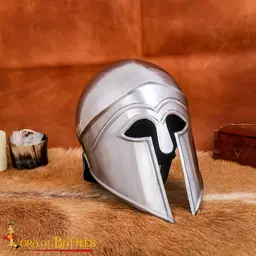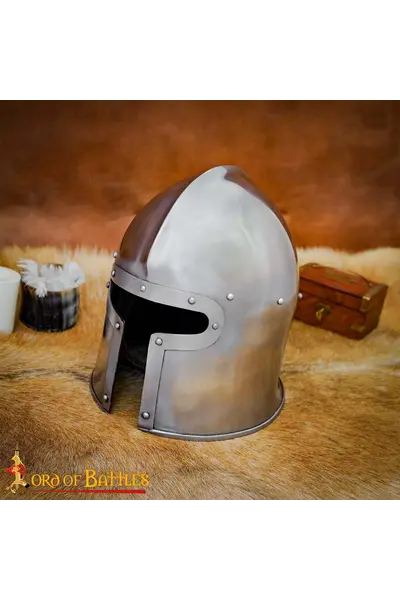Product description
This is a replica of a Corinthian-Italic helmet from the 5th century BC. This helmet type was especially popular in the Archaean period, the 8th to 6th century BC. From the 5th century BC. people began to prefer the Thracian helmet, which gave more field of vision. In Italy the helmet was worn by the Romans and Etruscans during the royal period. Handmade from 1.2mm (18 gauge) steel, this Corinthian helmet is lined with a comfortable and secure leather lining. With a circumference of approximately 68 cm (without lining) fits for head size 58-62 cm. (65 cm with lining). The height is approximately 31 cm and the width (from front to back) is 27.5 cm. The opening just below the nasal plate is 3 cm and the eye slits measure approximately (6×3.2) cm. The helmet insert can be removed to create more space in the helmet.
Details:
Head circumference: max. 65 cm
Height: 31 cm
Material: steel
Finish: polished
Steel thickness: 1.2 mm
Based on a historical original
Shipment weight (g): 3000 *
This item is produced in limited quantities only. This means that every piece is unique. Sizes & finish may vary lightly from piece to piece.
Maintenance & care
Prevent rust and corrosion by oiling your armour regularly. Remove rust easily with black sandpaper.
Choosing the size that fits you best
Add 3,5 cm to your head circumference if you wear an arming cap under your helmet.
Add 2,5 cm to your head circumference if you wear a chainmail coif under your helmet.
Add 6 cm to your head circumference if you wear both an arming cap and a chainmail coif under your helmet.
This armour is 1 mm thick and suitable for LARP battles, costumes and cosplay.
When packaging this item, we exclusively use 100% recycled plastic and recycled paper/cardboard from FSC certified forests. We reuse a large part of the material directly without the intervention of a recycling process.
Recycle the material by separating your waste:
1. Cardboard: separate or reuse your paper.
2. Plastic cushions, clothing bags and plastic tape: separate or reuse your plastic. If possible, pierce the cushions with a volume reduction needle.
3. Paper packaging for jewelry and small items: these have a plastic inner layer. Remove these, then separate your paper and plastic.
Read here about how we are committed to sustainability.





















